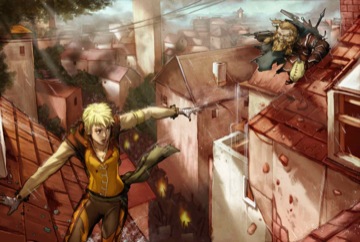 baron arem heshvaun
baron arem heshvaun
|
A few weeks ago I was at our regular PFS game and the party encountered some old school monsters and unusual terrain features
The combo of old school monsters and terrain where the party was forced to rethink conventional tactics quickly clued me in and I asked, "Is this a Tim Hitchcock mod?"
Sure enough it was. Sometimes combat terrain alone is enough to clue you n who developed a mod.
Either that or I've just been playing this game too long.
Great mod by the way Tim ;-)
| h2ofowler |
I also really like this article. As a former 40k player, I always liked the way terrain played such an important role in tactics. I would like to move those ideas into my RPG combats. Will you be covering anything like rooms filling with water or gas..or rat swarms as hazardous terrain possibilities?
 psionichamster
psionichamster
|
Nicely timed (unintentional or not) to coincide with the recently blogged print-on-demand terrain PDFs.
I can't wait to see what you bring next week.
My personal favorite? Hanging, swinging platforms over some hazard. If low-level enough, the party lacks flight capabilities and must rely on physical skills.
If they do fly, add in some gargoyles or gusts of random air jets. The game feel more like Metroid, which is a good thing, in my book.
Another GM had tunneling baddies, in a vertical shaft underground. They popped out of every surface imaginable.
| Stephen Radney-MacFarland Senior Designer |
Nicely timed (unintentional or not) to coincide with the recently blogged print-on-demand terrain PDFs.
I can't wait to see what you bring next week.
My personal favorite? Hanging, swinging platforms over some hazard. If low-level enough, the party lacks flight capabilities and must rely on physical skills.
If they do fly, add in some gargoyles or gusts of random air jets. The game feel more like Metroid, which is a good thing, in my book.
Another GM had tunneling baddies, in a vertical shaft underground. They popped out of every surface imaginable.
I think you will like what you see next week. It doesn't hit all of these, but probably enough to make you happy.
What about other ideas? Is there something that I am overlooking that some of you absolutely want to see in the next to blogs?





